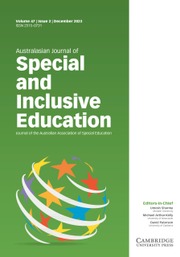Article contents
Integration to Inclusion in Hong Kong: Not an Easy Progression
Published online by Cambridge University Press: 11 May 2021
Abstract
This article describes the evolution of inclusive education in Hong Kong, moving from segregation via integration to inclusion. The outside influence of education policies and trends from Britain, Australia, and the United States are identified, and the current situation is described. In particular, obstacles that are encountered on the route to inclusion are compared with those found in other countries. These obstacles include large class size, teachers’ often negative attitudes, parents’ expectations, teachers’ lack of expertise for adapting the curriculum and for providing differentiated teaching, and ongoing conflicts between the notion of ‘inclusive schooling for all’ and the ‘academic standards agenda’.
Keywords
- Type
- Special Education Perspectives
- Information
- Australasian Journal of Special and Inclusive Education , Volume 45 , Issue 2 , December 2021 , pp. 268 - 280
- Copyright
- © The Author(s), 2021. Published by Cambridge University Press
Footnotes
This manuscript was accepted under the Editorship of David Paterson.
References
- 1
- Cited by


